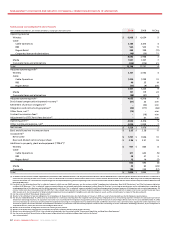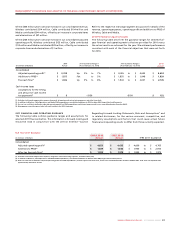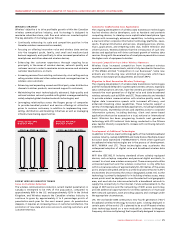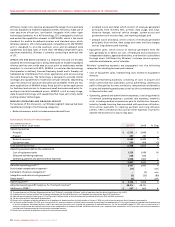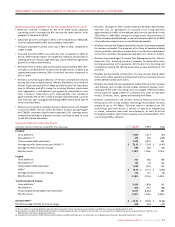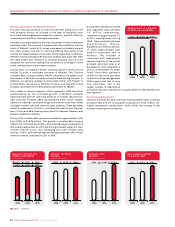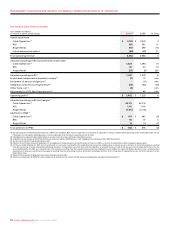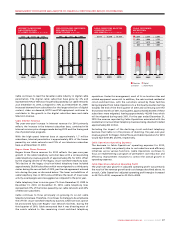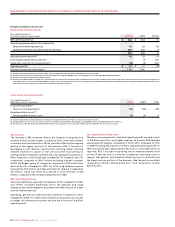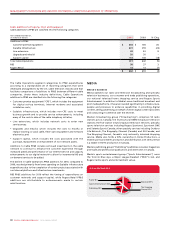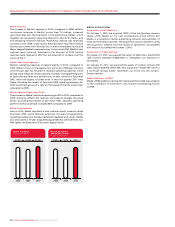Rogers 2010 Annual Report Download - page 28
Download and view the complete annual report
Please find page 28 of the 2010 Rogers annual report below. You can navigate through the pages in the report by either clicking on the pages listed below, or by using the keyword search tool below to find specific information within the annual report.
32 ROGERS COMMUNICATIONS INC. 2010 ANNUAL REPORT
Cable believes that the 860 MHz FTTF architecture provides sufficient
bandwidth to provide for television, data, telephony and other future
services, high picture quality, advanced two-way capability and
network reliability. This architecture also allows for the introduction of
bandwidth optimization technologies, such as switched digital video
(“SDV”) and MPEG4, and offers the ability to continue to expand
service offerings on the existing infrastructure. SDV has been
successfully deployed in almost all head-ends. In addition, Cable’s
clustered network of cable systems served by regional head-ends
facilitates its ability to rapidly introduce new services to large areas of
subscribers simultaneously. In new construction projects in major urban
areas, Cable is now deploying a cable network architecture commonly
referred to as fibre-to-the-curb (“FTTC”). This architecture provides
improved reliability and reduced maintenance due to fewer active
network devices being deployed.
Cable’s voice-over-cable telephony services are offered over an
advanced broadband IP multimedia network layer deployed across its
cable service areas. This network platform provides for a scalable
primary line quality digital voice-over-cable telephony service utilizing
Packet Cable and Data Over Cable Service Interface Specification
(“DOCSIS”) standards, including network redundancy as well as multi-
hour network and customer premises backup powering.
Cable operates on behalf of Wireless and RBS (including the recently
acquired Atria Networks LP), a North American transcontinental fibre-
optic network extending over 38,000 route kilometres providing a
significant North American geographic footprint connecting Canada’s
largest markets while also reaching key U.S. markets for the exchange
of data and voice traffic, also known as peering. In Canada, the network
extends from Vancouver in the west to St. John’s in the east. The assets
include local and regional fibre, transmission electronics and systems,
hubs, points of presence (“POPs”), and switching infrastructure. Cable’s
network extends into the U.S. from Vancouver south to Seattle in the
west, from the Manitoba-Minnesota border, through Minneapolis,
Milwaukee and Chicago in the mid-west and from Toronto through
Buffalo and Montreal through Albany to New York City in the east.
Cable has connected its North American network with Europe through
international gateway switches in New York City.
Where Cable does not have its own local facilities directly to a business
customer’s premises, the local service is provided under a third party
wholesale arrangement.
CABLE’S STRATEGY
Cable seeks to maximize
subscriber share, revenue,
operating profit and return on
invested capital by leveraging its
technologically advanced cable
networks and innovative
products and services to meet
the information, entertainment
and communications needs of
its residential and small business
customers. The key elements of
the strategy are as follows:
• Maintaining technologically
advanced cable networks
and systems clustered and
interconnected in and around
metropolitan areas;
• Offeringawideselectionofadvancedandinnovativeinformation,
entertainment and communications products and services over
its broadband networks, such as the ongoing expansion of its
HDTV, specialty and on-demand video services, increasingly faster
broadband Internet speeds, and emerging opportunities for home
monitoring and control;
• Ongoing focus on enhanced customer experience through the
quality and reliability of its innovative products, services and
customer support programs;
• Targeting itsproductandcontent developmentto the changing
demographic trends within its service territory, such as products
targeted to multicultural communities and small businesses;
• Continuingtoleadthedevelopmentandexpansionoftheonline
content and entertainment experience with the continued expansion
of its successful broadband video platform, Rogers On-Demand
Online;
• Continuing to deepen our presence and core connections in an
increasing number of customer homes with anchor products such as
broadband Internet, video and telephony; and
• Focusingondrivingdeeperpenetrationofitson-netdataandvoice
services into the small and medium-sized business segments within
and contiguous to its cable footprint.
RECENT CABLE INDUSTRY TRENDS
Investment in Improved Cable Television Networks and Expanded
Service Offerings
In recent years, North American cable television companies have made
substantial investments in the installation of fibre-optic cable, including
fibre to the home and premises initiatives, and electronics in their
respective networks and in the development of Internet, digital cable
and voice-over-cable telephony services. These investments have
enabled cable television companies to offer expanded packages of
digital cable television services, including VOD and SVOD, pay television
packages, PVR, HDTV programming, increasingly fast tiers of Internet
services, and telephony services. These investments have enabled cable
television companies to offer increased speed and quality of service in
their expanded digital television packages, PVR, HDTV programming,
higher speed Internet and telephony services.
Increased Competition from Alternative Broadcasting Distribution
Undertakings
As fully described in the section entitled “Competition in our
Businesses”, Canadian cable television systems generally face legal and
illegal competition from several alternative multi-channel broadcasting
distribution systems.
Growth of Internet Protocol-Based Services
The availability of telephony over the Internet has become a direct
competitor to Canadian cable television systems. Voice-over-Internet
Protocol (“VoIP”) local services are being provided by non-facilities-
based providers, such as Vonage, who market VoIP local services to the
subscribers of ILEC, cable and other companies’ high-speed Internet
services. In addition and as discussed below, certain television and
movie content is increasingly becoming available over the Internet.
Traditional TV viewing will be challenged by wide range of options
available to consumers such as over-the-top television (such as Apple
TV), online video offerings (such as Netflix) and Mobile TV.
In the enterprise market, there is a continuing shift to IP-based services,
in particular from asynchronous transfer mode (“ATM”) and frame relay
(two common data networking technologies) to IP delivered through
virtual private networking (“VPN”) services. This transition results in
lower costs for both users and carriers.
20102009
2008
2008
201
0
2009
$4,052$3,948$3,809
CABLE TOTAL REVENUE
(In millions of dollars)
MANAGEMENT’S DISCUSSION AND ANALYSIS OF FINANCIAL CONDITION AND RESULTS OF OPERATIONS


